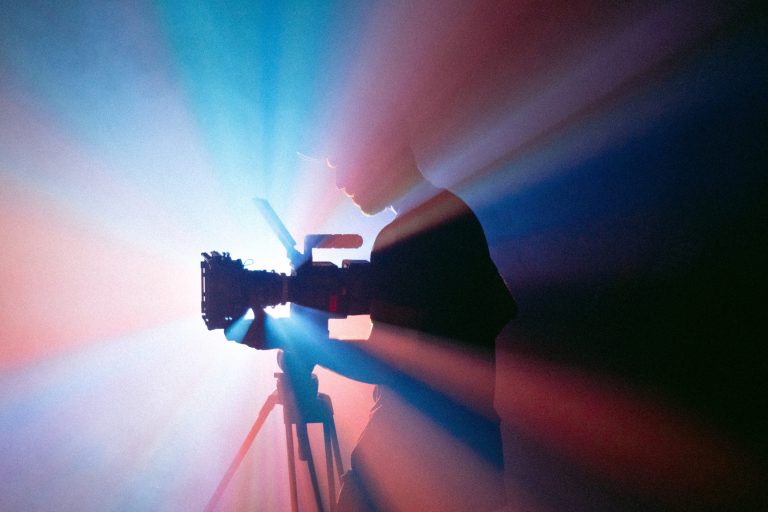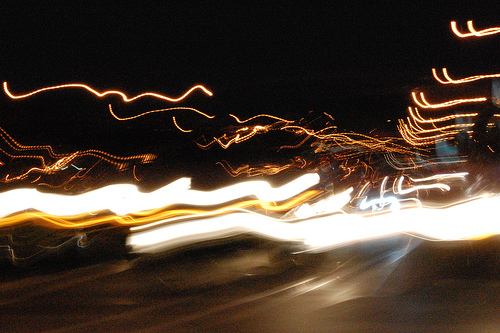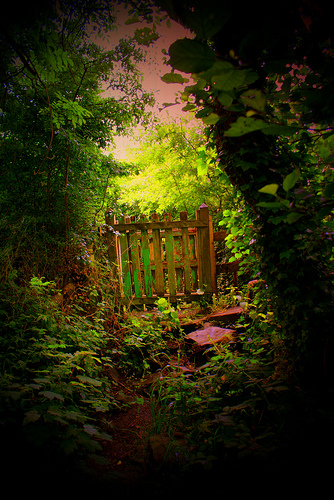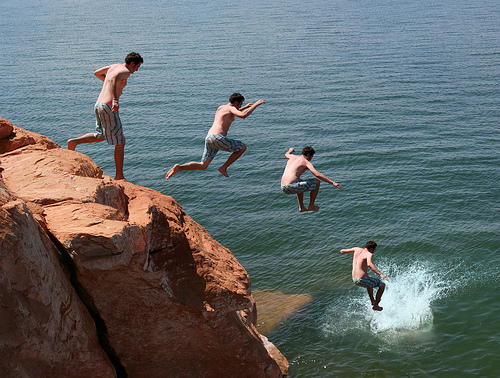Just Enough Sensory Detail to Set the Stage
We’ve been looking at Establishing Shots used in scripts, and we’ve seen how they don’t need to be lengthy. You only need a few moments to show the reader where the new scene is taking place. But rather than use dull narrative, we’ve seen how powerful it is to filter the shot through your POV character’s eyes. It’s not only great to show scenes through your character’s eyes but to use emotionally-packed descriptive words that can add power to your story. Sensory details work similarly.
A Tease before Establishing the Setting
Take a look at this Establishing Shot from the movie Jurassic Park written by Michael Crichton and directed by Steven Spielberg. Notice how Crichton uses an Extreme Close-Up to show minute detail, teasing the audience with the imagery shown in the opening moments. He then switches to a more traditional Establishing Shot to ground the locale for the start of the story.
EXTREME CLOSEUP of glowing honey-colored stones. Their shapes ABSTRACT as THE CAMERA EXAMINES air bubbles and crystalline patterns.
MOVING UP AND OVER this amber abstraction, the CAMERA FINDS unusual shapes and imperfections caught in the glassy stone: flecks of dirt, hairs, cracks. STILL MOVING. STARBURSTS OF LIGHT ricochet off the different surfaces of the stones.
CAMERA TURNS along a creamy stretch of amber. IT TURNS IN DEEPER, abstracting the picture further only to find A TINY BLUR that suddenly RACKS INTO FOCUS – a bug, a mosquito lodged within an amber tomb. It is folded on its back.
SLOW MOTION as the tip of a fine-pointed drill bores into the amber toward the trapped bug. Orange flecks fly. The mosquito trembles. The drill continues, stopping just before it touches the tiny body.
A SHINY PAIR of thin needle-nose pliers reach in the borehole and extricate the mosquito remains. These are dropped on a brightly lit glass slide. A conveyor belt starts, and the slide moves along, arriving under a long-lensed microscope.
IN MICROSCOPIC PERSPECTIVE, a thin needle pierces the bug and delicately removes a fragment of tissue.
PINCERS snare the fragment, dropping it into a narrow tube. The tube SPINS, faster and faster until it is a BLUR on the screen.
THE SCREEN FLOODS with an INFRA-RED LIGHT. Gray, oval shapes rock in a neutral mist.
WASH OUT TO:
HOT SUN overhead in a BIG SKY –
EXT BADLANDS – AFTERNOON
Lodged in the cracked earth are the partially-exposed fossilized remains of A VELOCIRAPTER, a carnivorous dinosaur. WIDEN OUT to a SWEEPING PANORAMA of a dinosaur dig, a major excavation filled with workers shoveling earth and stone, making measurements, taking photographs, scribbling notes, and conferring with each other.
The center of all this activity is one man. In a roped-off area that circumscribes the exposed bones of the raptor, is DR. ALAN GRANT, head paleontologist. Good-looking, late 30s, with a thin beard.
Grant lies on his belly, completely absorbed in a small piece of bone. A GROUP OF TWELVE STUDENTS, notebooks in hand, await his next sentence.
CLOSE ON – the tiny bone. Grant’s nose touches it.
Grant brushes the bone with a toothbrush. Then he decides on a quicker way to clean it. He licks it. Excited by his discovery, he gets to his feet and addresses his students, who listen raptly.
Notice how Crichton makes a dramatic shift from the detail of a tiny bug trapped in amber to a “sweeping panorama” of the dinosaur dig. He quickly shows just where the first true scene will unfold, then locks on to his main character for the scene: Dr. Grant. Without wasting any time, the viewer is drawn into action, with Dr. Grant finding a bone and showing it to his students. How much time is spent establishing the scene? Very little. Perhaps under a minute of screen time. But it’s enough to do just what needs to be done: establish where this scene is taking place.
Now for the Novel Version . . .
If you’ve read the novel, you may recall it doesn’t start with these scenes at all. In fact, the scene introducing the dig begins at page thirty-four, and doesn’t quite have the punch of Crichton’s screenplay (he wrote both). Take a look at the novel version:
Visitors found the badlands depressingly bleak, but when Grant looked at this landscape he saw something else entirely. This barren land was what remained of another, very different world which had vanished eighty million years ago. In his mind’s eye, Grant saw himself back in the warm, swampy bayou that formed the shoreline of a great inland sea.
Crichton goes on with a few paragraphs of backstory and exposition that may or may not be interesting to the reader, and which ends with telling he’s in northern Montana. Then we hear someone calling his name, and we get this as the true Establishing Shot:
He stood, a barrel-chested, bearded man of forty. He heard the chugging of the portable generator, and the distant clatter of the jackhammer cutting into the dense rock on the next hill. He saw the kids working around the jackhammer, moving away the big pieces of rock after checking them for fossils. At the foot of the hill, he saw six tipis of his camp, the flapping mess tent, and the trailer that served as their field laboratory. And he saw Ellie waving to him, from the shadow of the field laboratory.
From there, Ellie yells there’s a visitor, and Grant’s attention shifts to the blue truck driving over the rutted road kicking up dust as it heads toward him. He doesn’t spend pages detailing the weather—only a hint of wind flapping the tipis (although I always feel giving a bit of the weather and time of day/time of year helps fix the character more specifically in the setting) or describing how many students are digging, what they’re wearing, what the fossils look like. Crichton wants to get the reader into the action of the scene, and he knows most people will have a general feel for what an archaeological dig might look like. He leaves those details for the reader’s imagination to fill in.
A Bit of Sensory Detail Adds the Magic
What he does choose is a touch of sensory detail—sound. Just mentioning the jackhammer and the generator gives texture and implies much. A generator means they are too far from civilization to tap into local power lines. A jackhammer implies hard labor and a forceful attack on nature. Serious hard work. Important work. Six tipis means he has a good-sized crew, and they are roughing it out in the badlands. No fancy RVs here, but they’re “kids” to his protagonist, who is forty years old, which shows how his main character is seeing what’s going on around him.
Again, Crichton gives just enough detail to establish the shot through his POV character’s eyes, then moves onto what’s important—building to the high moment of the scene. If you don’t remember what that is, you can grab a copy of the novel and read it. But it will be there, as Crichton was a master at scene structure and made sure every scene had a purpose in advancing his plot.
This week, look at some Establishing Shots in your novel or some other novels. See if you can focus on one or more sensory details that will give the right touch of flavor to the setting without going into lengthy detail. If you have many paragraphs of narrative setting up your scene, see if you can cut down to one, making every word count, aiming at evoking the setting from the POV of your character. See how this not only tightens your writing but gets your reader faster into the story action?












Hello. Love your articles. Very helpful. Although your analogies are wonderful teaching tools, when you use a screenplay for an example of what a writer creates, please be aware that shot choices in a movie are choices made by the director alone, not the screenwriter. Ever. Screenwriters working on a spec script (your own story that you hope to sell) should never embed shot choices into their screenplays as that’s a sign of an amateur who does not understand the role of the director. Just wanted to give you an FYI on this one.
Hi Brooke, that’s the first I’ve ever heard that. I read hundreds of scripts my mother wrote as I was growing up, and the writer always indicated the shots. She was also story editor on a series, and before the director ever was given a script, all the scenes were in there with the shots indicated. In fact, I’ve never seen a screenplay written for a TV or film episode or movie that did not have the camera shots specifically indicated. My stepfather was a movie director as well, so I was fairly saturated in the industry. Not sure what your background is, but maybe your experience was in a different country or era. I can’t say how things are done in 2013, but this was how if was done in the twentieth century.
I think Brooke may be thinking exclusively about contemporary spec scripts. I was taught, in a recent screenwriting class led by a former script doctor for a major studio, that in a spec script one should leave as much leeway as possible for the director to determine shots. Types of shots may be suggested in the narration (e.g., “The sun rises over the sleepy mountain village. Mr. Brown exits his curio shop with a push broom and starts to sweep the sidewalk in front of it.”), but that’s about as far as the spec writer is expected to go. If you’re under contract to write a particular script, however, it becomes a different matter, especially if you’re writing the actual shooting script, which of course would then contain all the shots.
Miss Lakin:
This is great stuff. I just eat it up.
Sincerely,
James M. Copeland
I’m new to the group, just today in fact. Putting my toe in the water to see if this group’s discussions are of the nature I’m hoping to find: professional and concise. Some other groups get too long-winded and many comments turn into ego trips. I was afraid Suzanne’s comments were going to be just like those, especially since they took us to a different site, but they turned out to be exactly the type of information I desired. I’ll monitor this group for awhile and check out some of the previous discussions to avoid redundancy when I do post one.
Thanks to all who participate.
Nice to meet you, Jim. Not sure we’re a “group” here, but hope the instruction and posts and helpful to you in your writing journey.
For me the most important point were the sonic details that described the setting in the novel. Employing senses other than sight places the reader in the scene as the character experiences it.
Thanks for the example and comments.